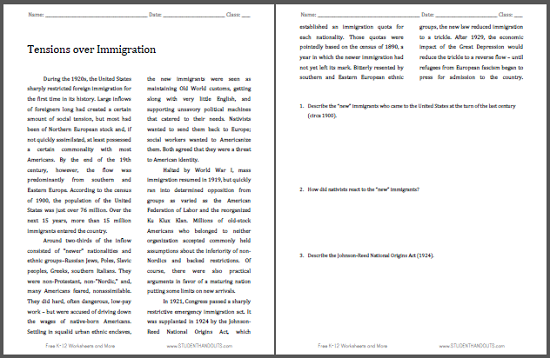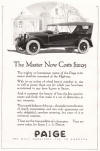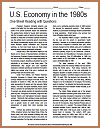During the 1920s, the United States sharply restricted foreign immigration for the first time in its history. Large inflows of foreigners long had created a certain amount of social tension, but most had been of Northern European stock and, if not quickly assimilated, at least possessed a certain commonality with most Americans. By the end of the 19th century, however, the flow was predominantly from southern and Eastern Europe. According to the census of 1900, the population of the United States was just over 76 million. Over the next 15 years, more than 15 million immigrants entered the country.
 Around two-thirds of the inflow consisted of "newer" nationalities and ethnic groups–Russian Jews, Poles, Slavic peoples, Greeks, southern Italians. They were non-Protestant, non-"Nordic," and, many Americans feared, nonassimilable. They did hard, often dangerous, low-pay work – but were accused of driving down the wages of native-born Americans. Settling in squalid urban ethnic enclaves, the new immigrants were seen as maintaining Old World customs, getting along with very little English, and supporting unsavory political machines that catered to their needs. Nativists wanted to send them back to Europe; social workers wanted to Americanize them. Both agreed that they were a threat to American identity.
Around two-thirds of the inflow consisted of "newer" nationalities and ethnic groups–Russian Jews, Poles, Slavic peoples, Greeks, southern Italians. They were non-Protestant, non-"Nordic," and, many Americans feared, nonassimilable. They did hard, often dangerous, low-pay work – but were accused of driving down the wages of native-born Americans. Settling in squalid urban ethnic enclaves, the new immigrants were seen as maintaining Old World customs, getting along with very little English, and supporting unsavory political machines that catered to their needs. Nativists wanted to send them back to Europe; social workers wanted to Americanize them. Both agreed that they were a threat to American identity.
Halted by World War I, mass immigration resumed in 1919, but quickly ran into determined opposition from groups as varied as the American Federation of Labor and the reorganized Ku Klux Klan. Millions of old-stock Americans who belonged to neither organization accepted commonly held assumptions about the inferiority of non-Nordics and backed restrictions. Of course, there were also practical arguments in favor of a maturing nation putting some limits on new arrivals.
In 1921, Congress passed a sharply restrictive emergency immigration act. It was supplanted in 1924 by the Johnson-Reed National Origins Act, which established an immigration quota for each nationality. Those quotas were pointedly based on the census of 1890, a year in which the newer immigration had not yet left its mark. Bitterly resented by southern and Eastern European ethnic groups, the new law reduced immigration to a trickle. After 1929, the economic impact of the Great Depression would reduce the trickle to a reverse flow – until refugees from European fascism began to press for admission to the country.
Questions with answers in bold:
1. Describe the “new” immigrants who came to the United States at the turn of the last century (circa 1900).
Russian Jews, Poles, Slavic peoples, Greeks, and southern Italians; all non-Protestant, non-"Nordic," and, many Americans feared, nonassimilable.
2. How did nativists react to the “new” immigrants?
They wanted to send them back to Europe.
3. Describe the Johnson-Reed National Origins Act (1924).
It established an immigration quota for each nationality.
Click here to print this worksheet.



 Around two-thirds of the inflow consisted of "newer" nationalities and ethnic groups–Russian Jews, Poles, Slavic peoples, Greeks, southern Italians. They were non-Protestant, non-"Nordic," and, many Americans feared, nonassimilable. They did hard, often dangerous, low-pay work – but were accused of driving down the wages of native-born Americans. Settling in squalid urban ethnic enclaves, the new immigrants were seen as maintaining Old World customs, getting along with very little English, and supporting unsavory political machines that catered to their needs. Nativists wanted to send them back to Europe; social workers wanted to Americanize them. Both agreed that they were a threat to American identity.
Around two-thirds of the inflow consisted of "newer" nationalities and ethnic groups–Russian Jews, Poles, Slavic peoples, Greeks, southern Italians. They were non-Protestant, non-"Nordic," and, many Americans feared, nonassimilable. They did hard, often dangerous, low-pay work – but were accused of driving down the wages of native-born Americans. Settling in squalid urban ethnic enclaves, the new immigrants were seen as maintaining Old World customs, getting along with very little English, and supporting unsavory political machines that catered to their needs. Nativists wanted to send them back to Europe; social workers wanted to Americanize them. Both agreed that they were a threat to American identity.








